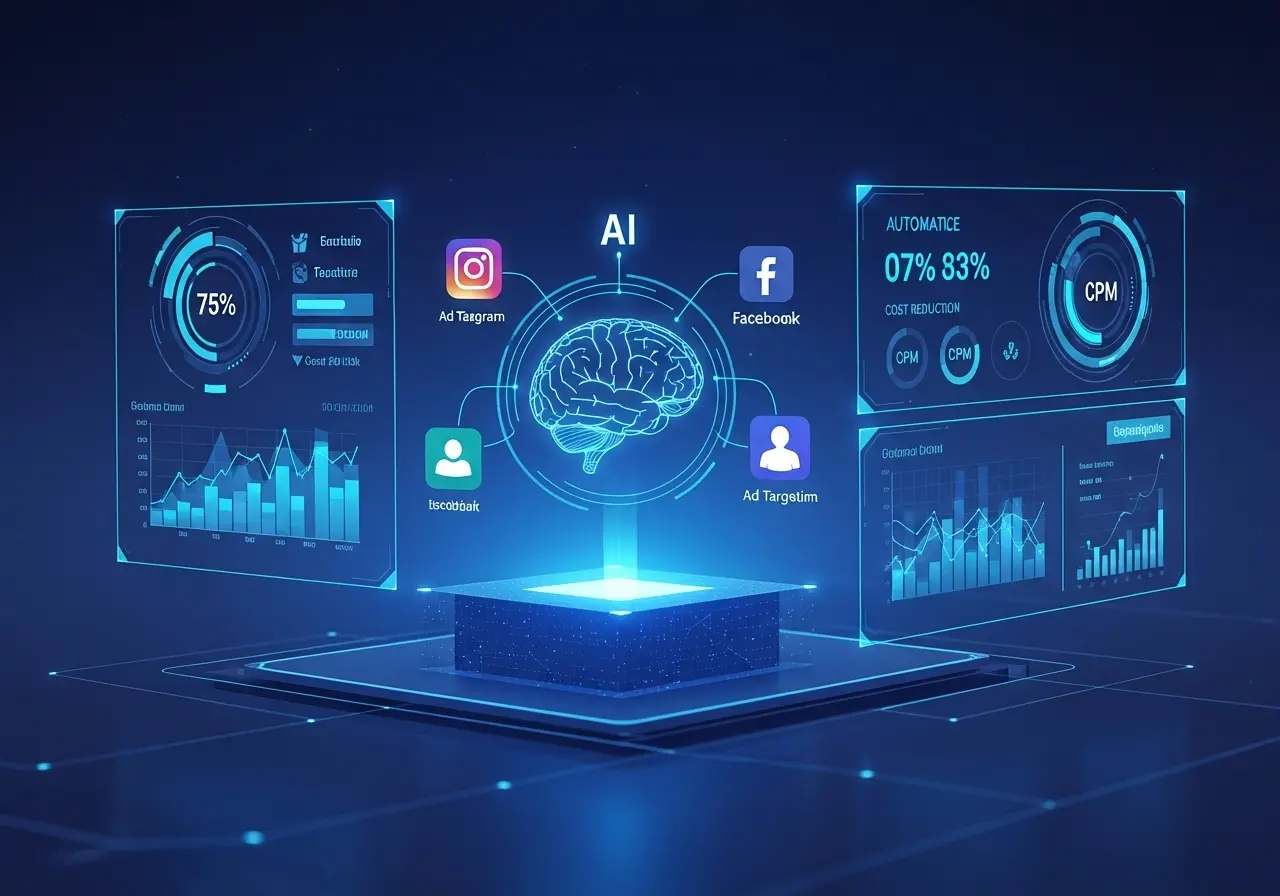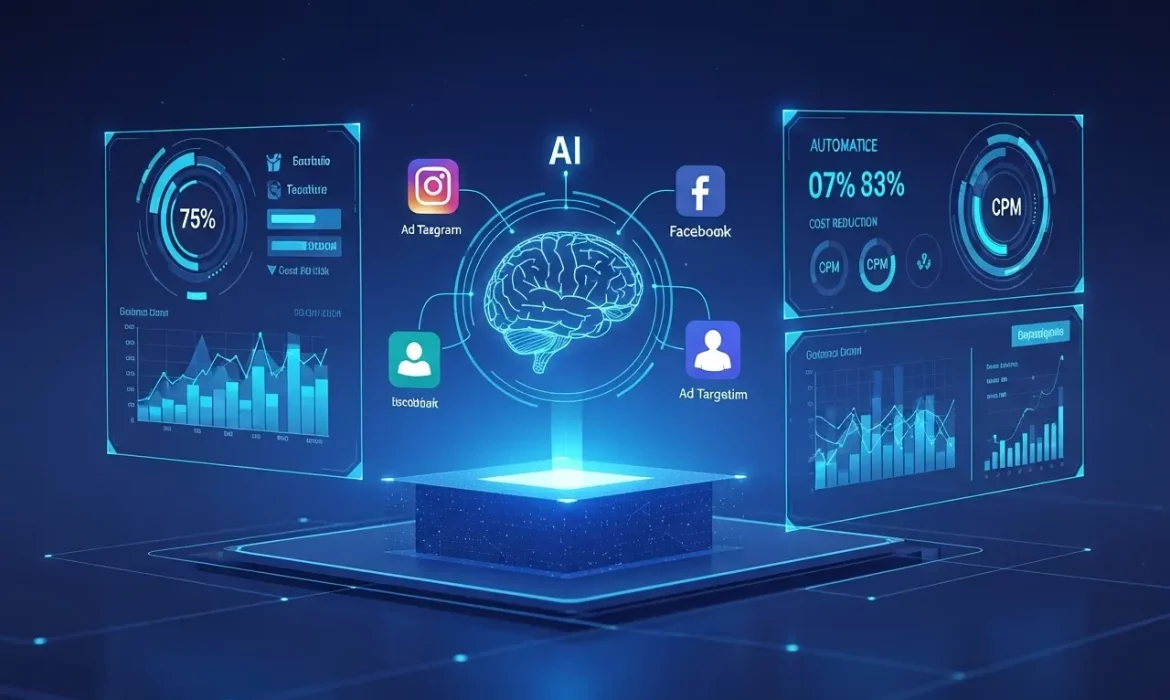Are you torn between wider reach and rising CPMs in your ad campaigns? AI promises to zero in on ideal audiences, but 46% of marketers already use AI for ad targeting and optimization.
Average Facebook CPM climbed to $12.74 in June 2025, and Google Ads now sees a median CPM of $18.75 in April 2025. That cost jump raises big questions about ROI.

This post unpacks AI’s mechanics, platform differences, real benchmarks, and expert tactics. You’ll know when AI boosts reach or drive up your CPM and how to make it work for you.
Why This AI’s Impact Matters?
AI now powers the majority of ad auctions, with algorithmically enabled strategies accounting for 59.5% of global ad spend in 2024 and expected to reach 79% by 2027.
Overlooking this shift can leave your budgets splintered and performance lagging. This change rewrites traditional cost structures.
Misreading AI’s impact on CPM spikes and reach gaps results in wasted spend and missed audiences. Understanding how targeting algorithms learn enables you to steer budgets toward high-return segments.
Fluency in AI targeting principles also sharpens vendor evaluations, streamlines team alignment, and shields ROI from hidden fees. Clarity today translates directly into consistent results tomorrow.
The Reach vs CPM Paradox
Now that you see why AI is reshaping budgets, let’s dig into how it stretches reach and nudges up CPM. On one side, algorithms unlock hidden audiences.
On the other hand, those same algorithms can bid your costs higher. You need to master both to avoid surprises.
What Drives Reach Expansion?
AI scans billions of data points, such as browsing habits, past purchases, or ad interactions, to find lookalikes of your best customers.
You tap entirely new segments without crafting audiences by hand. That means fresh prospects fill your funnel faster than ever.
Big reach comes with a catch. The algorithm sometimes extends into fringe segments where competition intensifies. You trade broader exposure for slightly higher CPMs, but the volume boost can ultimately lead to more conversions overall.
Why CPMs Spike and Fall
During the learning phase, AI bids aggressively to test which users are most likely to convert. Expect CPM jumps of 20-40% in week one as the model responds to performance signals. Think of it as a research budget for smarter campaigns.
Once the system gathers enough conversion data (usually after 10 to 14 days), bids shift toward proven winners. CPM then often drops by 15-30% because the algorithm focuses only on high‑value users.
The Learning Phase Effect
Every AI tool needs room to learn. You set it loose, watch it explore, and feed it back performance data. That early investment drives efficiency later.
To manage this, cap budgets and define success metrics up front. Let the model roam within those guardrails. The payoff is deeper reach at a lower cost per impression once the learning phase ends.
AI Bidding Mechanics and Auction Dynamics
Let’s pull back the curtain on how AI bids in ad auctions, because it isn’t magic, it’s data‑driven math that tests strategies and adapts on each impression. Understanding these mechanics helps you predict cost swings and spot hidden biases.
1. Real‑Time Bid Adjustments
Every time an impression becomes available, AI evaluates the opportunity in milliseconds. Smart Bidding algorithms crunch dozens of signals, like device, location, time, and more, and update your bid for that single auction.
This live tweaking means you never overpay in slow periods or miss out when competition heats up.
2. Data Signals and Competition
AI feeds on data, and more signals mean tougher competition. Platforms pull in first-party data, contextual cues, and even weather or inventory levels to value each impression accurately.
That drive for precision pushes up CPMs when many brands compete for the same high-value users.
3. High‑Value Segment Pressure
Targeting premium segments, such as frequent buyers or high‑ticket shoppers, comes at a higher cost.
AI bids confidently when the lifetime value exceeds the cost, driving CPMs up by as much as 25% compared to broad audiences. Your job is to decide when that cost spike delivers real ROI and when to dial back into mid‑funnel groups.
Meta vs Google Ads: How AI Shapes Reach and Cost
Meta and Google capture nearly half of all digital ad spend, yet their AI features play by different rules.
Meta relies on automated budgets and dynamic placements, while Google promotes smart bidding across search, display, and video. Understanding these nuances enables you to tailor strategies for both reach and cost efficiency.
Meta Ads
Meta’s AI tools thrive on first‑party data and engagement signals. You get broad reach with minimal setup and deeper insights when you link your CRM. Here’s how to choose between hands‑off automation and manual controls.
Campaign Budget Optimization vs Manual Bidding
Campaign Budget Optimization pools your budget across ad sets and allows AI to shift spend toward top performers automatically.
Manual bidding gives you granular control but lacks real‑time adaptation, so you risk overfunding underperforming segments.
Advantage+ Audience and AI‑Powered Placements
Advantage+ Audience expands targeting by tapping into off-platform inventory and hidden lookalikes, boosting reach without requiring additional audience building.
AI‑powered placements then choose the most relevant formats like stories, feeds, or in‑stream, so each impression lands where it matters most.
iOS 14 Constraints and Conversions API Fixes
Apple’s privacy changes cut off third‑party tracking, driving up CPMs as lost signal spurs broader bids.
Meta’s Conversions API restores key data server‑side, improving signal quality and helping AI keep bids aligned with actual performance.
Google Ads
Google’s smart bidding algorithms adjust to user intent in every auction. You trade some budget control for scale across Search, Display, and YouTube. Here are the main strategies and their cost implications.
eCPC, Target CPA, and Target ROAS Strategies
Enhanced CPC nudges bids up or down per auction signal to hit more conversions.
Target CPA and Target ROAS optimize toward set cost‑or‑return goals, often at slightly higher CPMs during the initial learning phase.
Performance Max Reach vs CPM Benchmarks
Performance Max campaigns serve ads across Search, Discovery, and YouTube, delivering broad reach at a cost of about 20% higher CPM compared to standard search.
You gain unified reporting and automated placements in exchange for a premium CPM.
Search vs Display vs Video CPM Comparisons
Search CPMs tend to run at their highest because of strong purchase intent. Display campaigns trade lower CPMs for massive reach.
Video ads hover at the top of the cost curve, often commanding the highest CPMs for premium in‑stream inventory.
Benchmark Your AI Ads: Metrics That Matter
Context sets clear targets. These key metrics keep your AI campaigns honest and efficient.
| Metric | Definition | Why It Matters |
|---|---|---|
| CPM | Cost per one thousand impressions | Tracks the cost efficiency of your ads |
| eCPM | Effective CPM – revenue or value per thousand impressions | Compares buys by clicks and views equally |
| Impression Share | Percentage of auctions won out of total eligible auctions | Reveals when budget or bids limit your reach |
| Unique Reach | Number of distinct users exposed to your ads | Prevents ad fatigue and frequency waste |
Tracking CPM, eCPM, and impression share helps you spot budget leaks fast. Unique reach ensures you avoid overexposure, so your message stays fresh.
Let’s see real CPMs across top platforms in 2025. Use these north‑star numbers to set realistic goals and measure AI’s true impact on cost and reach.
| Platform | 2025 Avg CPM |
|---|---|
| Meta (Facebook & Instagram) | $8.15 [Source] |
| TikTok | $2.97 [Source] |
| YouTube | $2.16 [Source] |
| Snapchat | $6.43 [Source] |
| $6.03 [Source] |
3 Best Practices to Balance Reach and Cost
Turning on AI alone won’t protect your budget. Utilize these safeguards and data strategies to manage CPMs effectively while expanding your reach.
1. Set Cost Caps and Target CPAs
Cost caps put a hard stop on runaway bids, protecting your bottom line. Target CPAs shift AI’s focus from raw impressions to actual conversions. This dual setup ensures every dollar works toward measurable results, not just extra eyeballs.
2. Use Dynamic Budget Pacing
Align spend with auction volume across days and hours. Dynamic pacing smooths out peaks and valleys, allowing you to avoid overspending during high-demand times. AI stretches your budget further by investing most when bid competition is favourable and pacing back when costs spike.
3. Leverage First‑ and Zero‑Party Data
First‑party data sharpens audience definitions using your customers’ real behaviours. Zero‑party data collects direct preferences for even richer targeting. Feeding these signals into AI reduces CPM by eliminating wasted impressions and enhancing ad relevance.
How EvenDigit Upraised 60% Conversion for an LED Bulb Provider
It started with a family-run LED light bulb brand facing flat performance. Their ad spend wasn’t driving results, and campaigns lacked structure. We stepped in to apply AI-driven strategies.
We rebuilt their Google Ads account, shifting to Smart Shopping and dynamic remarketing with real-time bidding. We infused first-party signals from site behavior and purchase history. Then we introduced AI-driven creative tests that swapped headlines and images based on real-time performance.
The results were immediate. Conversions jumped by 60% and conversion value climbed by 80%. Impressions rose 48% while ad clicks soared 94.64% versus previous campaigns. The cost per conversion decreased, maximizing ROI on every budget dollar.
This case proves how expert-guided AI tactics translate into measurable growth and why partnering with EvenDigit means unlocking that same potential for your brand.
Looking Ahead: AI’s Next Moves in Ad Targeting
AI keeps evolving, and so should your ad strategies. New capabilities will reshape how you balance reach and cost.
Predictive Audiences and Intent Signals
Predictive audiences tap into live signals and past behaviour to forecast buyer intent before it becomes obvious.
You reach prospects at the moment they start researching solutions, beating competitors to the punch and boosting relevance.
Conversational and Dynamic Ad Formats
Conversational ads enable users to interact with chat interfaces directly within the ad, guiding them seamlessly from discovery to conversion.
Dynamic video and shoppable ads adjust visuals and calls to action in real-time based on viewer context for increased engagement.
Contextual AI for Cookie less Targeting
With third-party cookies fading, contextual AI matches ads to page content and real-time signals, rather than relying on user identity.
You maintain reach and stable CPMs by aligning ads to moments that matter, without relying on personal tracking.
You Need Experts by Your Side
AI is transforming ad planning, execution, and performance across every channel. You need Meta ads and Google ads specialists to guide smart bidding, creative optimization, and reach-cost trade-offs.
Our team has guided hundreds of brands through AI-driven campaigns, setting cost caps, pacing budgets, and leveraging first-party and zero-party data for real impact.
With EvenDigit leading your ad targeting strategy, you’ll strike the perfect balance of reach and CPM, driving measurable growth in 2025 and beyond.
EvenDigit
EvenDigit is an award-winning Digital Marketing agency, a brand owned by Softude (formerly Systematix Infotech) – A CMMI Level 5 Company. Softude creates leading-edge digital transformation solutions to help domain-leading businesses and innovative startups deliver to excel.
We are a team of 70+ enthusiastic millennials who are experienced, result-driven, and hard-wired digital marketers, and that collectively makes us EvenDigit. Read More




